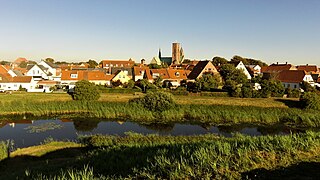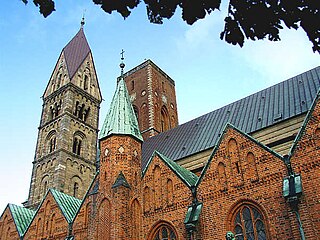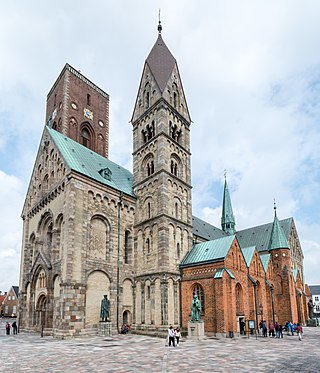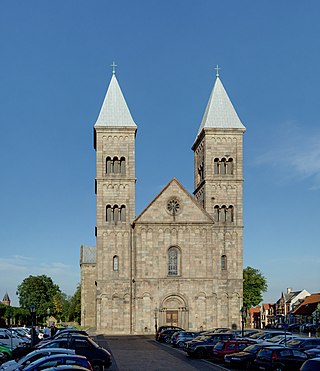
Ribe is a town in south-west Jutland, Denmark, with a population of 8,295 (2024). It is the seat of the Diocese of Ribe. Until 1 January 2007, Ribe was the seat of both a surrounding municipality and county. It is now part of the enlarged Esbjerg Municipality in the Region of Southern Denmark. It is the oldest town in Denmark.

Eric IV, also known as Eric Ploughpenny or Eric Plowpenny, was King of Denmark from 1241 until his death in 1250. His reign was marked by conflict and civil wars against his brothers.

Aarhus Cathedral is a cathedral in Aarhus, Denmark. It is the longest and tallest church in the country, at 93 m (305 ft) in length and 96 m (315 ft) in height.

The former Diocese of Aarhus was a Roman Catholic diocese in Denmark, founded in the 10th century and dissolved during the Protestant Reformation. The diocese included the counties of Aarhus and Randers, the islands of Samsø and Tunø, and, after 1396, part of the county of Viborg.

The Catholic Church in Denmark is part of the worldwide Catholic Church, under the spiritual leadership of the Pope in Rome. The Diocese of Copenhagen covers the whole of the country, as well as the Faroe Islands and Greenland, and as such is one of the geographically largest Catholic dioceses by area in the world.

The former Diocese of Børglum was a Roman Catholic diocese in Northern Jutland, Denmark. It has also been referred to as the Diocese of Vestervig or the Bishopric of Vendsyssel. The diocese included the historic districts of Vendsyssel, Hanherred, Thy, and Mors.

The Diocese of Ribe is a diocese within the Church of Denmark. Ribe Cathedral serves as the central cathedral within the diocese. Since 2014, the bishop has been Elof Westergaard.

The former Diocese of Odense was a Roman Catholic diocese in Denmark which included the islands of Funen, Langeland, Tåsinge, Lolland, Falster, Als, and Ærø. Its episcopal see was located in Odense at St. Canute's Cathedral.

Ribe Cathedral or Our Lady Maria Cathedral is located in the ancient city of Ribe, on the west coast of southern Jutland, Denmark. It was founded in the Viking Age as the first Christian church in Denmark by Ansgar, a missionary monk from Hamburg, under permission of the pagan King Horik I. The cathedral has experienced several damaging events throughout its long history and has been restored, expanded and decorated repeatedly. As it stands today, Ribe Cathedral is the best preserved Romanesque building in Denmark, but reflects a plethora of different architectural styles and artistic traditions. It ranks among the most popular tourist attractions in Denmark and has been awarded two stars in the Michelin guide.

Øm Abbey was a Cistercian monastery founded in 1172 in the Diocese of Aarhus near the town of Rye, between the lakes of Mossø and Gudensø in central Jutland, Denmark. It is one of many former monasteries and abbeys in the highland region of Søhøjlandet.

The Diocese of Aarhus is one of 10 dioceses in the Church of Denmark, with headquarters in the city of Aarhus. The diocese covers a large district of northeast Jutland and comprises 14 deaneries, of which four cover the extent of Aarhus city itself.

The election of Christian III as king of Denmark on 4 July 1534 was a landmark event for all of Denmark and also Norway. It took place in St. Søren's Church in the town of Rye in eastern Jutland, where the Jutlandic nobility elected Prince Christian, son of King Frederick I and Duke of Schleswig and Holsten, as king. This brought about the Count's Feud and later also led to the implementation of the Protestant Reformation in Denmark and Norway.

The former Diocese of Viborg was a Roman Catholic diocese in Denmark. It was established in 1065 and was dissolved in 1536 during the Protestant Reformation.

The former Norwegian Catholic diocese of Hamar existed from 1152 to 1542, when the Protestant Reformation turned it into a bishopric of the Lutheran state church. The cathedral see was at Hamar, and the diocese included the (modern) counties of Hedmark, Oppland, and the middle part of Buskerud. It also included some parts of Telemark.
Nicholas I was Bishop of Schleswig between 1209 and 1233. Since 1192 he de facto, though not consecrated, officiated during the flight and following royal captivity of his predecessor Bishop Valdemar (1193–1206).
Events from the 1530s in Denmark.

Peder Palladius was a Danish theologian, Protestant reformer, and bishop of Zealand. As the first protestant bishop in Denmark, he oversaw the conversion of ecclesiastic affairs. He helped create the church ordinance which founded the Church of Denmark, produced a Danish translation of the Bible, and removed Catholic images and rituals from his diocese.
Reginbrand was a bishop of the Ancient See of Aarhus. He was ordained by bishop Adaldag of Hamburg-Bremen in 948 in the first ordination of bishops in the Scandinavian countries. The ordination had the explicit support of the pope who wished to expand Christianity into northern Europe. Adaldag ordained three bishops for the Jutland region; Harald to Slesvig, Ljufdag to Ribe and Reginbrand to Aarhus. The meeting was attended by Otto the Great and Louis IV along with 34 German, French and Danish bishops, in the St. Remigius Kirche in Ingelheim am Rhein.
Christian was a bishop of the Diocese of Aarhus, Denmark, from c. 1060. Christian was the second bishop of the Ancient See of Aarhus and the first after almost a century of vacancy in the diocese. Christian is remembered for participating in one of the last viking raids on England in 1070. The dates of his birth and death are unknown, however it is assumed that he died sometime before 1102, when Ulfketil succeeded him as Bishop of Aarhus.













